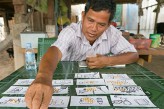Branchless Banking: Tapping The Unbanked November 7, 2010

The Consultative Group to Assist the Poor (CGAP) explored the potential of branchless banking reaching the unbanked. Mark Pickens, MFI Specialist at CGAP, used data from 8 branchless banking service providers including M-Pesa in Kenya and Tanzania, Banco Postal in Brazil, FINO in India, GCash and Smart Money in the Philippines, WIZZIT in South Africa, and WING in Cambodia. The research shows that branchless banking reaches the unbanked in significant numbers and at a pace that surpasses the growth of MFIs.
In a separate study, a 2008 survey found that 75 percent of M-Pesa users were already using their mobile accounts to store money. Over 95 percent of the survey respondents found the service not only safer but faster, more convenient, easier to use, and cheaper than traditional methods.
These developments indicate a range of exciting opportunities in servicing the 200 million migrants and the billions of poor people across the globe with no bank accounts to their name.
There are nearly 5 billion mobile subscribers in the world and more airtime vendors than all the bank branches in the developing world. It shouldn’t be a surprise, therefore, that M-Pesa has already inspired 60 copycat businesses across the world.
According to an estimate by CGAP, mobile banking service providers could witness revenues of around $8 billion by 2012 by simply expanding their services to the presently unbanked masses.
Although m-banking is gaining traction in countries including Australia, Britain, Singapore and South Korea, it is in the developing world where m-banking is exerting its immense potential. M-banking is the best opportunity yet to deliver financial services to the 1 billion people in the world who don’t have a bank account, but do have a cell phone.
According to Ross Levine, a Senior Economist at Brown University, the quality and reach of a country’s financial services are crucial determinants of economic growth
This year, Safaricom projects it will transfer the equivalent of 20 percent of Kenya’s GDP through M-Pesa. Olga Morawczynski, an M-Pesa Expert from the University of Edinburgh, estimates that rural households that are mobile money subscribers see their incomes increase 5 to 30 percent. See the article “The M-Banking Revolution” for more information.
Another important development on the mobile remittance front was announced month between MTN Group, one of the leading mobile wallet deployments in the world, and Western Union. The purpose of this partnership is to introduce international mobile remittance services in the 21 countries where MTN operates, allowing MTN subscribers to conveniently send and receive Western Union Money Transfer transactions using their MTN MobileMoney accounts.
Technology convergence is rapidly being realised today and technology solutions from growing industries such as Remittances and Telecommunications are coming together to transform the way the banked and the unbanked bank!
Related Posts
-

RemitONE Feature Focus Webinar: Securer Transactions, Anti-Fraud Tools & White-Label Mobile App
In this webinar, our speakers will unveil powerful tools to combat fraudulent onboarding, ensure secure transaction management on both Android…
November 30, 2023 -

RemitONE Winners of the CrossTech ‘White Label Provider’ of the Year Award at CrossTech World 2023 in Miami, USA!
RemitONE wins 'White Label Provider' of the Year Award at CrossTech 2023
November 30, 2023 -

We’re Attending Crosstech 2023 | 14-16 November 2023
Our excitement is building for the upcoming Crosstech event. We look forward to connect with potential partners and catch up with our valued clients. For those planning to attend the Crosstech event, we extend a warm invitation to schedule a meeting with the RemitONE team.
October 24, 2023 -

Innovation in Payments and Remittances (IPR) Awards 2023
2023 award winners of the Innovation in Payments and Remittances (IPR) Global event
October 23, 2023 -

RemitONE partners with GBG for global identity verification and AML compliance solutions
RemitONE is thrilled to announce its strategic partnership with GBG, a global expert in digital location, identity verification, and fraud prevention software. This collaboration empowers Money Transfer Organisations (MTOs) worldwide to effectively verify customer identities across the globe, maintain regulatory compliance, and streamline customer onboarding.
September 21, 2023 -

Trust Payments Partners With Innovation in Payments and Remittances (IPR)
We’re thrilled to announce that Trust Payments, a leading global payments company, will be a Platinum Sponsor for the upcoming…
August 24, 2023